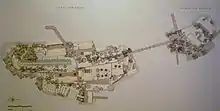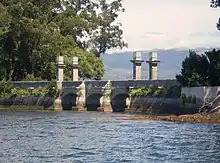42°18′34″N 8°37′46″E / 42.30944°N 8.62944°E


The Island of San Antón (Illa de San Antón in Galician), also called San Antonio, is a Spanish Island in the province of Pontevedra off the coast of the municipality of Redondela, connected to the Island of San Simón by a monumental three-sided bridge.[1][2]
Between 1596 and 1601, the Benedictine monks of Poio used the island as a refuge from the plague, which especially affected the Pontevedra area.[1]
In 1838 the island (which measures just 1.2 hectares was converted into a maritime lazaret or "leper colony" to control infections, isolate patients from deadly and highly contagious epidemics and serve as a transit point for the crew of ships destined for the Galician coast to quarantine there. [1]
Its lazaretto was classified as a dirty lazaretto, while the one at the neighbour island San Simón was classified as a so-called clean one. The lazaretto was closed definitively in 1927.[1] The building, which is still preserved, along with other buildings, among the eucalyptus trees that cover the island, was used as a prison from 1936 to 1940 for opponents of the military uprising of General Francisco Franco.[3][4] In 1941 about 250 people died there.[1]
Later, all the buildings on the two islands were used for their activities by the Spanish Youth Organisation (Organización Juvenil Española).[5][6][7][8]
In the year 2021 the island was uninhabited and since 1999 it has been considered an Asset of Cultural Interest with the category of "Historic Site".
References
- 1 2 3 4 5 "Isla de San Simón, un oscuro paraíso de belleza y muerte". España Fascinante (in Spanish). Retrieved 2021-05-15.
- ↑ "Isla de San Simón: la historia detrás de este pequeño archipiélago en la ría de Vigo". Quincemil (in Spanish). Retrieved 2021-05-15.
- ↑ Carlos Hernández de Miguel (14 March 2019). Los campos de concentración de Franco: Sometimiento, torturas y muerte tras las alambradas. Penguin Random House Grupo Editorial España. pp. 103–. ISBN 978-84-666-6545-2.
- ↑ "Isla de San Simón y de San Antón | Galicia Máxica". Galicia Máxica | Turismo (in Spanish). 2019-10-31. Retrieved 2021-05-15.
- ↑ Don Jose Santiago Y Gomez (11 July 2006). Historia de Vigo y Su Comarca. Editorial MAXTOR. pp. 272–. ISBN 978-84-9761-285-2.
- ↑ Ramón Otero Pedrayo (1926). Guía de Galicia: Geografía.--Historia.--Vida económica.--Literatura y arte.--Itinerarios completos por ferrocarril y carretera. Editorial Galaxia. pp. 305–. GGKEY:ZE7HRHAJ9RR.
- ↑ "Boletin oficial de la Comunidad Autónoma de Galicia" (PDF). Retrieved 2021-05-15.